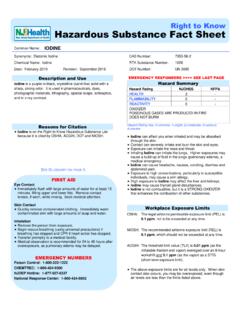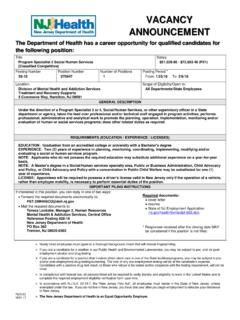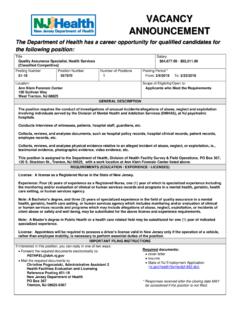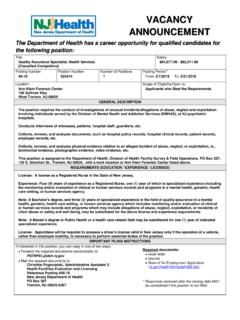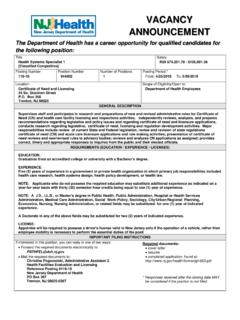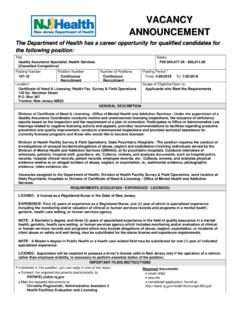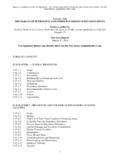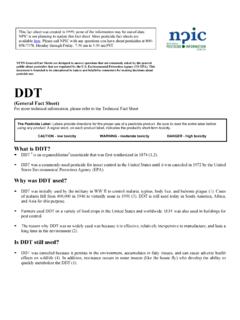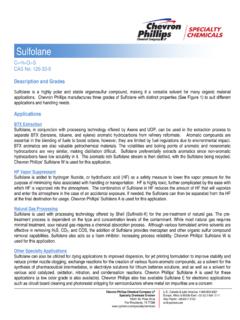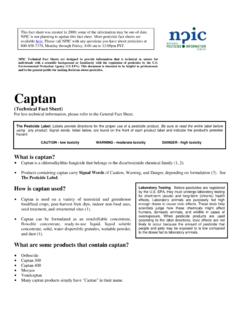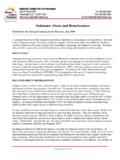Transcription of Right to Know Hazardous Substance Fact Sheet - New Jersey
1 Right to know Hazardous Substance fact Sheet Common Name: DIETHANOLAMINE. Synonyms: DEA; 2,2 - Dihydroxydiethylamine CAS Number: 111-42-2. Chemical Name: Ethanol, 2,2 -Iminobis- RTK Substance Number: 0686. Date: June 2003 Revision: February 2012 DOT Number: UN 1760. Description and Use EMERGENCY RESPONDERS >>>> SEE LAST PAGE. Diethanolamine is a white, crystalline (sand-like) solid or a Hazard Summary colorless to yellow, syrupy liquid with a mild Ammonia-like Hazard Rating NJDOH NFPA. odor. It is used in specialty textiles, weed killers, detergents, HEALTH - 3. shampoos, paints and metal-working fluids. FLAMMABILITY - 1. REACTIVITY - 0. f ODOR THRESHOLD = ppm CORROSIVE. f Odor thresholds vary greatly. Do not rely on odor alone to POISONOUS GASES ARE PRODUCED IN FIRE.
2 Determine potentially Hazardous exposures. Hazard Rating Key: 0=minimal; 1=slight; 2=moderate; 3=serious;. 4=severe Reasons for Citation f Diethanolamine can affect you when inhaled. f Diethanolamine is on the Right to know Hazardous f Diethanolamine is CORROSIVE and contact can irritate Substance List because it is cited by ACGIH, DOT, NIOSH, and burn the skin and eyes with possible eye damage. DEP, IARC, NFPA and EPA. f Diethanolamine may cause a skin allergy. f This chemical is on the Special Health Hazard Substance f Inhaling Diethanolamine can irritate the nose and throat List. causing coughing and wheezing. f Exposure to Diethanolamine can cause headache, nausea and vomiting. f Diethanolamine may affect the liver and kidneys. SEE GLOSSARY ON PAGE 5.
3 Workplace Exposure Limits FIRST AID NIOSH: The recommended airborne exposure limit (REL) is 3. 15 mg/m averaged over a 10-hour workshift. Eye Contact f Immediately flush with large amounts of water for at least 30. minutes, lifting upper and lower lids. Remove contact ACGIH: The threshold limit value (TLV) is 1 mg/m3 (as the lenses, if worn, while flushing. Seek medical attention. inhalable fraction and vapor) averaged over an 8-hour workshift. Skin Contact f Quickly remove contaminated clothing. Immediately wash contaminated skin with large amounts of water. Inhalation f Remove the person from exposure. f Begin rescue breathing (using universal precautions) if breathing has stopped and CPR if heart action has stopped. f Transfer promptly to a medical facility.
4 EMERGENCY NUMBERS. Poison Control: 1-800-222-1222. CHEMTREC: 1-800-424-9300. NJDEP Hotline: 1-877-927-6337. National Response Center: 1-800-424-8802. DIETHANOLAMINE Page 2 of 6. Determining Your Exposure Other Effects f Diethanolamine may cause a skin allergy. If allergy f Read the product manufacturer's Material Safety Data develops, very low future exposure can cause itching and a Sheet (MSDS) and the label to determine product skin rash. ingredients and important safety and health information f Diethanolamine may affect the liver and kidneys. about the product mixture. f For each individual Hazardous ingredient, read the New Jersey Department of Health Hazardous Substance fact Medical Sheet , available on the RTK website Medical Testing ( ) or in your facility's RTK If symptoms develop or overexposure is suspected, the Central File or Hazard Communication Standard file.
5 Following are recommended: f You have a Right to this information under the New Jersey f A qualified allergist can help diagnose skin allergy. Worker and Community Right to know Act and the Public f Liver and kidney function tests Employees Occupational Safety and Health (PEOSH) Act if you are a public worker in New Jersey , and under the Any evaluation should include a careful history of past and federal Occupational Safety and Health Act (OSHA) if you present symptoms with an exam. Medical tests that look for are a private worker. damage already done are not a substitute for controlling exposure. f The New Jersey Right to know Act requires most employers to label chemicals in the workplace and You have a legal Right to request copies of your medical testing requires public employers to provide their employees with under the OSHA Access to Employee Exposure and Medical information concerning chemical hazards and controls.
6 Records Standard (29 CFR ). The federal OSHA Hazard Communication Standard (29. CFR ) and the PEOSH Hazard Communication Mixed Exposures f More than light alcohol consumption can cause liver Standard ( 12:100-7) require employers to provide damage. Drinking alcohol may increase the liver damage similar information and training to their employees. caused by Diethanolamine. This fact Sheet is a summary of available information regarding the health hazards that may result from exposure. Duration of exposure, concentration of the Substance and other factors will affect your susceptibility to any of the potential effects described below. Health Hazard Information Acute Health Effects The following acute (short-term) health effects may occur immediately or shortly after exposure to Diethanolamine: f Contact can irritate and burn the skin and eyes with possible eye damage.
7 F Inhaling Diethanolamine can irritate the nose and throat causing coughing and wheezing. f Exposure to Diethanolamine can cause headache, nausea and vomiting. Chronic Health Effects The following chronic (long-term) health effects can occur at some time after exposure to Diethanolamine and can last for months or years: Cancer Hazard f While Diethanolamine has been tested, it is not classifiable as to its potential to cause cancer. Reproductive Hazard f There is limited evidence that Diethanolamine may damage the male reproductive system (including decreasing the sperm count) in animals. DIETHANOLAMINE Page 3 of 6. Workplace Controls and Practices f All protective clothing (suits, gloves, footwear, headgear). should be clean, available each day, and put on before work.
8 Very toxic chemicals, or those that are reproductive hazards or sensitizers, require expert advice on control measures if a less toxic chemical cannot be substituted. Control measures Eye Protection include: (1) enclosing chemical processes for severely f For solid Diethanolamine, wear direct vent goggles when irritating and corrosive chemicals, (2) using local exhaust airborne particles or dust are present. ventilation for chemicals that may be harmful with a single f Wear indirect vent goggles when working with liquids that exposure, and (3) using general ventilation to control may splash, spray or mist. A face shield is also required if exposures to skin and eye irritants. For further information on the liquid is severely irritating or corrosive to the skin and workplace controls, consult the NIOSH document on Control eyes.
9 Banding at Respiratory Protection The following work practices are also recommended: Improper use of respirators is dangerous. Respirators should only be used if the employer has implemented a written f Label process containers. program that takes into account workplace conditions, f Provide employees with hazard information and training. requirements for worker training, respirator fit testing, and f Monitor airborne chemical concentrations. medical exams, as described in the OSHA Respiratory f Use engineering controls if concentrations exceed Protection Standard (29 CFR ). Only NIOSH. recommended exposure levels. approved respirators should be used. f Provide eye wash fountains and emergency showers. 3. f Wash or shower if skin comes in contact with a Hazardous f Where the potential exists for exposure over 1 mg/m , use a material.
10 Full facepiece respirator with a combination organic vapor f Always wash at the end of the workshift. and P100 cartridge. Increased protection is obtained from f Change into clean clothing if clothing becomes full facepiece powered-air purifying respirators. contaminated. f Leave the area immediately if (1) while wearing a filter or f Do not take contaminated clothing home. cartridge respirator you can smell, taste, or otherwise detect f Get special training to wash contaminated clothing. Diethanolamine, (2) while wearing particulate filters f Do not eat, smoke, or drink in areas where chemicals are abnormal resistance to breathing is experienced, or (3) eye being handled, processed or stored. irritation occurs while wearing a full facepiece respirator.

